Irrigation Help
Irrigation Help
Irrigation is necessary to maintain healthy plants. But sprinklers can be a prime source of water waste if they are not properly maintained – and that can increase your water bill unnecessarily as well. This page can help you water plants responsibly and keep your irrigation system running efficiently.
Using water Wisely is a way of life in California and the Santa Clarita Valley. The State is in the midst of a severe multi-year drought, and we don't have a drop to waste!
Did you know? More than half of an average home's water use is outdoors -- and often up to half of that is wasted due to broken or misaligned sprinklers, leaking vales, incorrectly programmed irrigation timers, and runoff caused by watering more than the soil can absorb. Small changes to increase your water-efficiency can add up to big water savings. To learn more, visit DroughtReadySCV.com.
Irrigation Types
- Spray heads
-
Spray heads are the most commonly used sprinkler for turf and shrubs. Heads are spaced according to the specific nozzle (which screws into the top of the head), but usually not more than 15 feet apart. They are usually pop-ups, popping-up during use and retracting afterwards.
Cycle and Soak: Spray heads apply water much faster than the clay soils in the Santa Clarita Valley can absorb. The “Cycle and Soak” method helps reduce run-off and encourages deep, healthy turf roots by applying water in a very short cycle (even one minute or less) and then waiting for the water to soak in before irrigating again. This irrigation best practice can be done manually, or by using a smart irrigation controller. With the controller, you can set it in "smart mode" and it will irrigate using the "cycle and soak" method. For this reason, "cycle and soak" is considered an irrigation best practice.
- Rotary heads
-
Rotary heads can shoot water 25-40 feet and are usually best for large turf areas such as parks and community-owned landscaping. Rotary heads are also typically pop-up heads that you only see while the irrigation system is watering.
Like spray heads, rotary heads apply water much faster than the clay soils in the Santa Clarita Valley can absorb, so landscapes irrigated with rotary heads would also benefit from the “Cycle and Soak” method mentioned above.
- Drip
-
Drip systems generally apply water at the same rate as the soil can accept it, eliminating run-off. Drip may require a pressure regulator for your irrigation system (separate from your house) to keep the pressure low. Drip is considered the ultimate in water use efficiency.
- Bubblers
-
Bubblers work best for trees with basins around them. Water is released from the bubbler at a faster rate than the soil can generally accept. But if there is a basin to contain the water, it will absorb over time.
Irrigation Tips and FAQs for the Santa Clarita Valley
During times of drought, click here to check for specific watering days and restrictions.
The information below is intended to provide general irrigation tips, best practices, and FAQs.
- What Time of Day Should I Water?
-
Typically, we recommend watering between 2 a.m. and 6 a.m. Watering within this window of time takes advantage of relatively low winds and less loss of water to evaporation.
- How Long Should I Water?
-
Because of our clay soils, running an irrigation system on a lawn for more than five minutes will result in runoff. Precise watering times vary depending on the type of watering device, soil, slope and plants.
- How Often Should I Water?
-
During times of drought, click here to check for specific watering days and restrictions.
Typically we recommend watering in the early morning hours between 2 a.m. and 6 a.m. as follows:
- Summer: No more than every other day
- Spring: No more than 3 times per week
- Fall: No more than 3 times per week
- Winter: No more than 1 time per week
Shut off irrigation system during the wet winter months and water only as needed during abnormally warm and dry periods. Use the following guidelines for conventional controller settings.
- Less is More
-
More damage is caused to our plants and grass from over-watering than from under-watering. When setting up your schedules be conservative to start and add more time when plants begin to look stressed.
- Losing its Spring
-
Grass signals that it needs water by losing its spring: When you walk across the lawn and see your footprints, your lawn probably needs to be watered.
- Grass Height
-
Set your mower to one of the highest settings. There are several reasons not to cut your grass too short:
- Keeping grass longer allows it greater surface area to carry out photosynthesis, which in turn results in healthier plants. In addition, taller grass grows slower than shorter grass. You can eliminate up to 20 percent of the mowing you do annually, saving time, gasoline and wear and tear.
- By keeping your grass longer, you can prevent most weeds from germinating—and thereby eliminate the need for herbicides.
- Take Control
-
Smart irrigation controllers, also known as weather-based irrigation controllers (wbic), are a great way to automate seasonal irrigation adjustments. Rebates for these devices are available. Click here to visit our Conservation Rebate Portal to learn more.
- Fall Irrigation
-
September through November, temperatures may still be relatively hot and your plants may seem to require similar watering patterns to the summer. However, keep in mind that as the days become shorter, evaporation decreases and plants’ water needs drop by approximately 30%.
Sample Irrigation Schedules
Many homeowners request irrigation schedules to help them program their traditional controllers. Any schedule provided needs to be adjusted based on the type of watering device, soil, slope and plants.
The tables below are samples of controller settings that may be successful in the Santa Clarita Valley. These tables assume that your irrigation system works efficiently, and that you have resolved any common irrigation issues.
Keep in mind that with the clay soil that is prevalent in the Santa Clarita Valley, “cycling and soaking,” turning the controller on for a recommended number of minutes several times an hour apart, results in deeper watering and a healthier root system.
| Spring | Summer | Fall | Winter | |
|---|---|---|---|---|
| Days Per Week | 3 | 4 | 2 | Off |
| Start Times Per Day | 3 | 3 | 3 | Off |
| Minutes Per Station | 5 | 5 | 5 | Off |
| Total Minutes Per Day | 15 | 15 | 15 | Off |
| Total Minutes Per Week | 45 | 60 | 30 | Off |
- Turf Grass (pop-up spray)
- Shrubs (pop-up spray)
- Drip (moderate water use plants)
Common Irrigation Challenges
Use the table below to identify common irrigation issues along with suggested solutions.
- Issue: leaning sprinkler nozzle
-
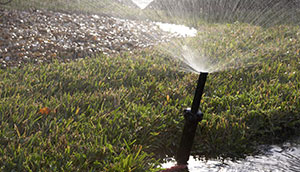
Suggested solution:
Straighten sprinkler nozzle - Issue: plants block the sprinkler nozzle
-
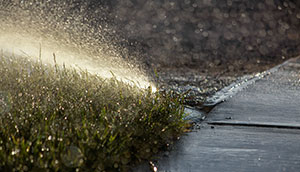
Suggested solution:
Trim plants or add a riser before the sprinkler nozzle - Issue: overspray
-
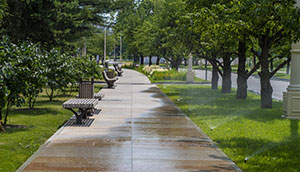
Suggested solution:
Adjust sprinkler nozzle and consider a pressure regulator or adjust timer. - Issue: misting or fogging
-
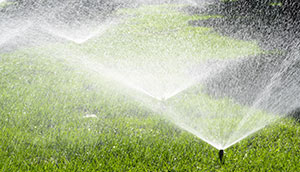
Suggested solution:
High pressure — Install a pressure regulator. - Issue: mismatched sprinkler heads
-
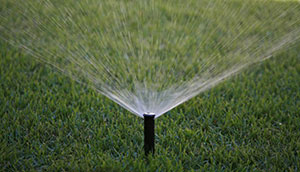
Suggested solution:
Replace with consistent sprinkler head type and brand.

